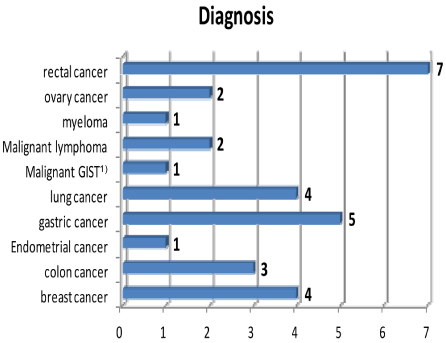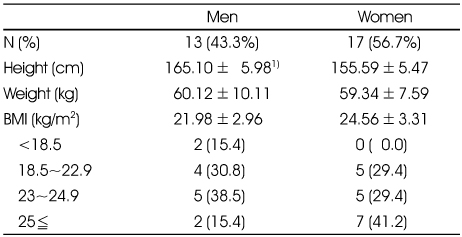Articles
- Page Path
- HOME > Korean J Community Nutr > Volume 21(1); 2016 > Article
-
Research Article
- Study on the Improvement of Dietary Life of Cancer Patients during Treatment by Nutrition Counseling
-
Keeyoun Hong, Yunjin Choi, Wanqin Yan, Hyunsook Lim
 , Jonghee Chyun
, Jonghee Chyun -
Korean Journal of Community Nutrition 2016;21(1):93-101.
DOI: https://doi.org/10.5720/kjcn.2016.21.1.93
Published online: February 29, 2016
Department of Food & Nutrition, College of Human Ecology, Inha University, Incheon, Korea.
- Corresponding author: Hyunsook Lim. Department of Food and Nutrition, Inha University, 100 Inha-ro, Nam-gu, Incheon 22212, Korea. Tel: (032) 890-3260, Fax: (032) 862-8120, hsim@inhauh.com
Copyright © 2016 The Korean Society of Community Nutrition
This is an Open-Access article distributed under the terms of the Creative Commons Attribution Non-Commercial License (http://creativecommons.org/licenses/by-nc/3.0/) which permits unrestricted non-commercial use, distribution, and reproduction in any medium, provided the original work is properly cited.
- 1,379 Views
- 4 Download
- 6 Crossref
Abstract
-
Objectives
- This study investigated the improvement of food habits and eating behavior of cancer patients during treatment through the continuous nutrition counseling and monitoring.
-
Methods
- Thirty cancer patients during treatment were participated in this study, and the first nutrition counseling and the first and second monitoring were conducted after 2-3 week intervals.
-
Results
- As a result of the nutrition counseling and monitoring, all patients improved to a great extent to consume 3 meals a day. The frequency of having breakfast was significantly increased with the nutrition counseling and continuous monitoring as well. The meal fixed quantity was stabilized and the eating speed slowed down as more nutrition counseling were done. The snack intakes of patients did not show any significant difference after the nutrition counseling but showed a slight decline after the monitoring. The frequencies of eating out and a late-night meal significantly decreased after the monitoring. The intakes of fish, meat, vegetables, milk and fruits needed for a well-balanced diet significantly increased as more nutrition counseling were done. The intakes of processed food were significantly decreased after the nutrition counseling and the intakes of fast food were significantly decreased as more nutrition counseling were done. The water intake of patients also significantly increased. In the eating behavior related to health, the frequency of drinking alcohol significantly decreased after nutrition counseling consultation and no patients had dietary supplements after the first monitoring.
-
Conclusions
- These results suggested that continuous nutrition counseling is effective in improving eating habits of cancer patients.
- 1. Korea Centers for Disease Control and Prevention. Report of the fifth Korea National Health and Nutrition Examination Survey (KNHANES V-1) [internet]. 2012; cited 2012 Aug 30]. Available from: http://knhanes.cdc.go.kr/.
- 2. Kelly K. An overview of how to nourish the cancer patient by mouth. Cancer 1986; 58: 8 Suppl. 1897-1901.ArticlePubMed
- 3. Torosian MH, Daly JM. Nutritional support in the cancer-bearing host, Effects on host and tumor. Cancer 1986; 58: 8 Suppl. 1915-1929.ArticlePubMed
- 4. Bottomley A. Pshchosocial problems in cancer care, a brief review of common problems. J psychiatric Health Nurs 1997; 4(5): 323-331.
- 5. Ovesen L, Allingstrup L, Hannibal J, Mortensen EL, Hansen OP. Effect of dietary counseling on food intake, body weight, response rate, survival and quality of life in cancer patients undergoing chemotherapy: A prospective, randomized study. J Clin Oncol 1993; 11(10): 2043-2049.ArticlePubMed
- 6. Matthews TW, Lampe HB, Dragosz K. Nutritional status in head and neck cancer patients. J Otolaryngol 1995; 24(2): 87-91.PubMed
- 7. Kim EK, Yang YH, Choi SM. Nutritional status of cancer patients upon admission. J Korean Acad Nurs 1999; 29(2): 271-280.ArticlePDF
- 8. Pierce JP, Newman VA, Flatt SW, Faerber S, Rock CL, Natarajan L. Telephone counseling intervention increases intakes of micronutrient and phytochemical-rich vegetable, fruit and fiber in breast cancer survivors. J Nutr 2004; 134(2): 452-458.PubMed
- 9. Snetselaar LG. Nutrition counseling skills. Clin Nutr Insight 1990; 16(7): 6.
- 10. Holli BB. Using behavior modification in nutrition counseling. J Am Diet Assoc 1988; 88(12): 1530-1536.ArticlePubMed
- 11. Lee JH. Introduction to counseling psychology. 5th ed. Seoul: Park Young Co; 1989. p. 3-17.
- 12. Choi KB, Lee SM, Lyu ES. Patient perceptions of clinical nutrition service. J Korean Diet Assoc 2012; 18(1): 59-71.Article
- 13. Do MH, Lee SS, Jung PJ, Lee MH. The effect of individual nutrition counseling on diet and nutrition status of postoperative breast cancer patients. Korean J Nutr 2004; 37(7): 557-565.
- 14. Moon SJ, Lee YM. A Computerized nutritional education program for meal management and nutritional assessment. J Nutr Health 1986; 19(3): 146-154.
- 15. Korean Society for the Study of Obesity. Guidebook for Obesity Medical in Koreans. Korean Society for the Study of Obesity; 2009. p. 17-18.
- 16. Korea National Statistical Office. Incidence rates of major cancers by age group[internet]. 2012; cited 2012 Aug 25]. Available from:http://www.cancer.go.kr/.
- 17. Lee SY, Shin MH, Sung MK, Paik HY, Park YK, Kim J. Establishment of Korean dietary guidelines for cancer prevention. Korean J Health Promot 2011; 11(3): 129-143.
- 18. World Cancer Research Fund / American Institute for Cancer Research. Food, Nutrition, Physical Activity, and the Prevention of Cancer: a Global Perspective. Washington DC. AICR [internet]. 2012; cited 2012 Aug 10]. Available from: http://www.wcrf.org/.
- 19. Cross AJ, Leitzmann MF, Gail MH, Hollenbeck AR, Schatzkin A, Sinha R. A prospective study of red and processed meat intake in relation to cancer risk. PLoS Med 2007; 4(12): e325.ArticlePubMedPMC
- 20. Cho GA, Paik HY, Park MS, Lee EK. Effects of nutrition counseling on diet and nutritional status of cancer patients on radiotherapy. J Nutr Health 2000; 33(2): 193-201.
- 21. Kim TY. Lifestyle modification for cancer prevention. Korean J Med 2003; 65(1): 136-140.
- 22. The Korean Nutrition Society. Korean Dietary Reference Intakes 2010. Dietary Reference Intakes 2010 Committee; 2010. p. 211-215.
- 23. Yoon EY. Dietary risk factors of gastric cancer & Nutrition intervention. Proceedings of 2004 Spring Symposium of the Korean Society of Community Nutrition; 2004 May 29; Seoul. p. 353-365.
- 24. Yoo TW. Evaluation of folk cancer remedies in Korea. Proceedings of 2004 Spring Symposium of the Korean Society of Community Nutrition; 2004 May 29; Seoul. p. 366-371.
- 25. Yun EY. Dietary risk factors of gastric cancer & Nutrition intervention. Proceedings of 2004 Spring Symposium of the Korean Society of Community Nutrition; 2004 May 29; Seoul. p. 353-365.
REFERENCES
The distribution of cancer diagnoses among study participants

Changes of food habits

1) Mean ± SD
2) 5: ≥5/week, 4: 4/week, 3: 3/week, 2: 2/week, 1: ≤1/week
3) 5: very regular, 4: regular, 3: usually, 2: irregular, 1: very irregular
4) 5: very fast, 4: fast, 3: usually, 2: slow, 1: very slow
5) 5: ≥2/day, 4: 1/day, 3: 3/week, 2: 2/week, 1: ≤1/week
6) 5: ≥1/day, 4: 4-5/week, 3: 2-3/week, 2: 1/week, 1: ≤2/month
*: p < 0.05, ***: p < 0.001
Figure & Data
REFERENCES
Citations

- Efficacy and Safety of Yukgunja-Tang for Patients with Cancer-related Anorexia: A Randomized, Controlled Trial, Pilot Study
Myung-Hyun Ko, Si-Yeon Song, Su-Jeong Ha, Jee Young Lee, Seong Woo Yoon, Ji-Hye Park, So-Jung Park, Hwa-Seung Yoo
Integrative Cancer Therapies.2021;[Epub] CrossRef - Cancer survivor's dietary safety management awareness and competency type
Yun Hwa Kim
Journal of Nutrition and Health.2020; 53(5): 532. CrossRef - Qualitative Study of Compliance with Nutritional Management in Colorectal Cancer Patient Undergoing Chemotherapy
Heejung Park, Hyonson Kil, Wookyoun Cho
Korean Journal of Community Nutrition.2020; 25(4): 303. CrossRef - Experiences of Inpatients Living with Lung Cancer in South Korea
Hae Ok Kim, Hyeon Jeong Kim
Asian Oncology Nursing.2020; 20(1): 28. CrossRef - The Effect of Symptom Experience, Nutritional Status, and Self Care on Quality of Life in Elderly Patients with Colorectal Cancer
Jeong Won Yeom, Yeon Ok Suh
The Korean Journal of Rehabilitation Nursing.2019; 22(1): 48. CrossRef - Effect of Nutrition Education on the Eating Habits and Quality of Life of Gastric Cancer Outpatients Undergoing Gastrectomy
YoonHee Jung, Joomin Lee
Korean Journal of Community Nutrition.2018; 23(2): 162. CrossRef

Fig. 1
General characteristics of the study subjects
1) Mean ± SD
Changes of food habits
1) Mean ± SD
2) 5: ≥5/week, 4: 4/week, 3: 3/week, 2: 2/week, 1: ≤1/week
3) 5: very regular, 4: regular, 3: usually, 2: irregular, 1: very irregular
4) 5: very fast, 4: fast, 3: usually, 2: slow, 1: very slow
5) 5: ≥2/day, 4: 1/day, 3: 3/week, 2: 2/week, 1: ≤1/week
6) 5: ≥1/day, 4: 4-5/week, 3: 2-3/week, 2: 1/week, 1: ≤2/month
*: p < 0.05, ***: p < 0.001
Intakes of snacks
1) N (%)
Intakes frequency of foods
1) Mean ± SD, ***: P < 0.001, **: P < 0.01
2) 5: 3/day, 4: 2/day, 3: 1/day, 2: 3/week, 1: ≤1/week
3) 5: ≥2/day, 4: 1/day, 3: 3/week, 2: 2/week, 1: ≤1/week
4) 4: >1,500 ml, 3: 1,000~1,500 ml, 2: 500~1,000 ml, 1: <500 ml
**: p < 0.01, ***: p < 0.001
Alcohol & supplementary health food intake frequency
1) Mean ± SD
2) 5: 1/day, 4: 4-5/week, 3: 2-3/week, 2: 1/week, 1: <2/month
***: p < 0.001
1) Mean ± SD
1) Mean ± SD 2) 5: ≥5/week, 4: 4/week, 3: 3/week, 2: 2/week, 1: ≤1/week 3) 5: very regular, 4: regular, 3: usually, 2: irregular, 1: very irregular 4) 5: very fast, 4: fast, 3: usually, 2: slow, 1: very slow 5) 5: ≥2/day, 4: 1/day, 3: 3/week, 2: 2/week, 1: ≤1/week 6) 5: ≥1/day, 4: 4-5/week, 3: 2-3/week, 2: 1/week, 1: ≤2/month *: p < 0.05, ***: p < 0.001
1) N (%)
1) Mean ± SD, ***: P < 0.001, **: P < 0.01 2) 5: 3/day, 4: 2/day, 3: 1/day, 2: 3/week, 1: ≤1/week 3) 5: ≥2/day, 4: 1/day, 3: 3/week, 2: 2/week, 1: ≤1/week 4) 4: >1,500 ml, 3: 1,000~1,500 ml, 2: 500~1,000 ml, 1: <500 ml **: p < 0.01, ***: p < 0.001
1) Mean ± SD 2) 5: 1/day, 4: 4-5/week, 3: 2-3/week, 2: 1/week, 1: <2/month ***: p < 0.001

 KSCN
KSCN




 Cite
Cite


